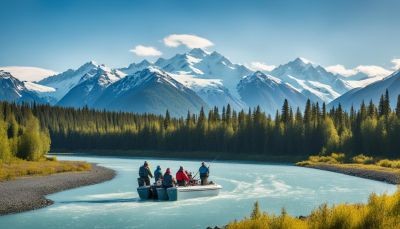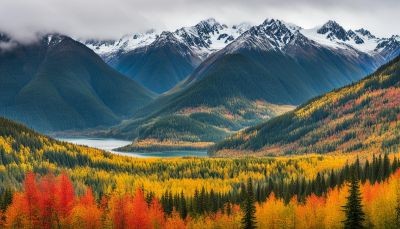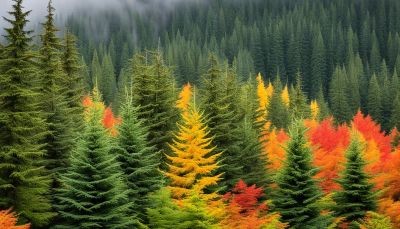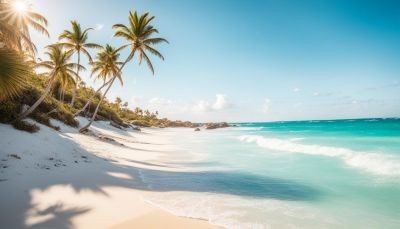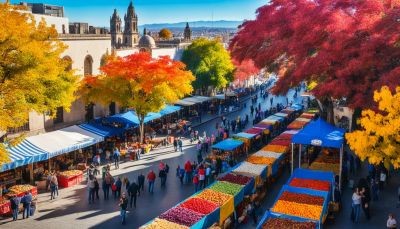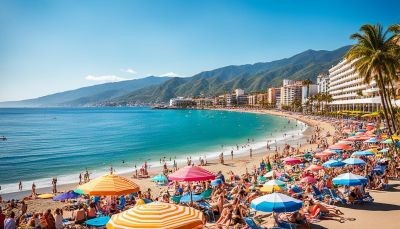Ever thought about the perfect time to visit Guadalajara, Mexico's second-largest city and Jalisco's cultural heart? While Guadalajara has great weather all year, certain seasons top the list for a visit. The fall months, from September through December, are widely regarded as the best time. Why is this season so special? Let's find out what makes Guadalajara shine during these months.
Key Takeaways
- Guadalajara enjoys a temperate, spring-like climate throughout the year due to its high elevation.
- The fall months from September to December offer the most pleasant weather, with little rainfall and comfortable temperatures.
- This shoulder season features a variety of cultural festivals and events, including the International Mariachi and Charrería Festival.
- Travelers can find more affordable rates and fewer crowds during the fall, making it an ideal time to visit.
- Exploring alternative airports and being flexible with travel dates can help you score the best deals on flights to Guadalajara.
Guadalajara's Temperate Climate
Guadalajara sits at about 5,100 feet above sea level. This gives the city a nice,
spring-like climate year-round. The height makes the weather perfect, not too hot like the lower lands and not too cold like the nearby mountains.
Elevation Plays a Crucial Role
The high altitude brings Guadalajara its temperate weather. Unlike cities at lower heights, Guadalajara stays cool in
summer and warm in
winter. This makes it a great spot for those wanting
pleasant weather any time they visit.
Average Temperatures and Rainfall
Temperatures in Guadalajara are usually between 95 and 55 degrees Fahrenheit. It's the perfect weather for exploring outdoor spots and enjoying the city's culture. Rainfall is about 40 inches each year, mostly from June to September. These rainfalls keep the landscape green and beautiful.
Spring in Guadalajara
As the sun warms up
Guadalajara,
Jalisco,
spring becomes perfect for exploring this lively city. It reaches
high 80s and low 90s Fahrenheit (mid-30s Celsius), great for outdoor fun. However, the
humidity rises, hinting at the coming
rainy season.
Spring ranks as the
second busiest time of year for tourism in Guadalajara, especially during
Easter and Holy Week holidays. It's also when the city hosts the
Festival Cultural de Mayo. This month-long event displays the city's
art, culture, and local traditions.
Warmest Season with Increasing Humidity
In Guadalajara, spring brings rising temperatures and humidity, giving a taste of the hot months ahead. This is the city’s
warmest season, ideal for strolling its lively streets. It's perfect for visiting markets and feeling the city's energetic vibe.
Festival Cultural de Mayo
The
Festival Cultural de Mayo shines in Guadalajara's spring. This month-long celebration highlights the city's
art, culture, and local traditions. The festival includes music, dances, art, and food, all celebrating
Jalisco's rich heritage.
Summer Rainy Season
In the
summer, Guadalajara,
Jalisco is warm but very wet. This season, from June to August, sees lots of afternoon
thunderstorms. Sometimes, there are
hail storms too. The rain changes the area, making it green from its usual dry look.
This wet period brings less tourists to Guadalajara. Because of this, traveling here in
summer might be cheaper. It's a good time to find deals on places to stay and other things. Don't miss the
Feria de Tlaquepaque, a two-week festival, and the
Jalisco Jazz Festival in nearby Tlaquepaque.
Feria de Tlaquepaque
and the
Jalisco Jazz Festival
Fall: The Best Time to Visit
When the hot summer fades, Guadalajara,
Jalisco, shines in its lovely fall season. This time, from mid-70s to high 80s Fahrenheit, means perfect weather. It cools at night. Fall is not as crowded as
winter, which lets you enjoy its rich culture fully.
International Mariachi and Charrería Festival
The
International Mariachi and Charrería Festival in September is a must-see. It's a thrilling mix of mariachi music, Mexican rodeo, and cultural shows. It shines a light on Jalisco's spirit and customs.
Fiestas de Octubre
By October, Guadalajara gets even more vibrant with
Fiestas de Octubre. This month-long celebration showcases the city’s art, food, and traditions. Expect parades, music, local dishes, and handmade crafts, offering an authentic Guadalajara experience.
International Book Fair and Film Festival
In fall, Guadalajara hosts
top events for book lovers and movie buffs. The
International Book Fair and Film Festival attract global talents. From authors to filmmakers, it's a stage for world-class literature and cinema.
Winter: Coolest Season
During
winter in Guadalajara, the temperature drops. Days are warm, reaching average highs in the 70s Fahrenheit. Nights can get chilly, dropping down to the 50s. Despite this, the sun still shines brightly, making the weather nice for many.
Mild Temperatures and Clear Days
Winter days in Guadalajara bring clear, sunny skies. This makes it perfect for being outside. The dry weather and sunshine are a great break from summer rains.
Navidalia Christmas Fair
The
Navidalia Christmas Fair lights up winter in Guadalajara. It's a joyful time to experience local culture, see handmade crafts, and taste holiday foods. This fair brings fun and cheer to all who visit.
Anniversary of Guadalajara's Founding
Guadalajara's founding is also celebrated in winter. This February event is important in the city's history. It shares insights into Guadalajara's culture and its key role in
Jalisco and Mexico's past.
Guadalajara, Jalisco: Best Months for a Weather-Savvy Trip
While
Guadalajara has good weather all year, the best time to go is from September to December. These months offer a mild, dry climate with rare rain. It's great for outdoor fun and exploring the city's culture. Plus, you'll find smaller crowds then, compared to winter.
| Best Travel Months | Weather Conditions | Crowd Levels |
|---|
| September - December | Mild and dry, with little rainfall | Smaller crowds and fewer tourists |
| Other Seasons | Varying temperatures and precipitation | Larger crowds and more tourists |
Planning to visit
Guadalajara,
Jalisco in the fall is wise. You'll get to fully enjoy the city's lively culture in nice weather. Also, there will be less people around, making your trip more relaxing.
Packing Tips for Each Season
When heading to Guadalajara, Jalisco, packing right for the season is crucial. In
spring and
summer, choose light, airy clothes. Don't forget a waterproof jacket or umbrella for sudden showers.
As the
autumn chill sets in, add layers to your suitcase. Include long sleeves, pants, and maybe a cozy sweater or jacket. These will keep you warm at night.
For
winter, think warm. Pack jeans, long sleeves, and a heavy sweater or jacket. Mornings and nights in Guadalajara can get quite chilly.
| Season | Recommended Packing |
|---|
| Spring and Summer | Lightweight, breathable clothing; waterproof jacket or umbrella |
| Autumn | Layers, long pants, long-sleeved shirts, light sweater or jacket |
| Winter | Warm clothing, including jeans, long-sleeved shirts, and a warm jacket or sweater |
Choose the right clothes for the
Guadalajara, Jalisco weather. This ensures you enjoy every moment, whatever the season.
Top Events and Festivals
Guadalajara, the colorful heart of Jalisco, is known for its many festivals. These events run all year long. From the
International Mariachi and Charrería Festival in September to the
Fiestas de Octubre lasting a month, the city is always alive with fun.
Every November, the
International Book Fair draws people from across the globe. For movie fans, there's the
International Film Festival, a time to celebrate great movies.
The
Festival Cultural de Mayo in Guadalajara highlights its rich cultural events each year. In winter, the
Navidalia Christmas Fair and Guadalajara's birthday in February celebrate its history.
Love mariachi music? Then, you'll love Guadalajara's music festivals. Want to enjoy street parties and top-notch cultural events? Then, Guadalajara is the perfect destination for you. Your trip there will be filled with amazing memories.
Shoulder Season Deals
For those wanting to save on their journey to
Guadalajara, Jalisco, late spring and early fall are perfect. At this time, hotel prices drop, and the city sees less visitors. The weather is still nice, so you can enjoy the city's culture and join
local events without spending too much or dealing with big crowds.
| Season | Hotel Rates | Crowd Levels |
|---|
| Shoulder Season (Late Spring and Early Fall) | More Affordable | Fewer Crowds |
| Peak Season (Winter and Summer) | Higher Prices | Larger Crowds |
Planning your
Guadalajara, Jalisco visit for the
shoulder seasons means experiencing more culture and fun. You won't have to deal with the high costs and many tourists. It's a great chance to dive into the city's festivals and happenings while enjoying budget-friendly prices and less crowded spots.
Alternative Airports for Cheaper Flights
Planning a trip to Guadalajara, Jalisco? Thinking about options near Los Angeles can save you big. Los Angeles International Airport (LAX) is easy, but it's often pricier. Look into flying from
Ontario International Airport (ONT) or
Hollywood Burbank Airport (BUR). You might save a lot of money going this route.
Ontario International Airport
Ontario International Airport (ONT) is east of Los Angeles. It's great for finding
cheaper flights to Guadalajara. This airport is smaller than LAX, which means its flights are usually less expensive. Choosing ONT not only saves money but also means flying close to Los Angeles.
Hollywood Burbank Airport
Hollywood Burbank Airport (BUR) sits north of downtown Los Angeles. It's a hub for budget-friendly flights, especially to Mexico, like Guadalajara, Jalisco. You may score a better deal on your flight while staying near the LA area.
Miguel Hidalgo Airport
Don't forget about Guadalajara's second airport, Miguel Hidalgo (GDL). Sometimes, domestic carriers offer sweet deals on flights there. Considering GDL could cut costs even more on your trip to Jalisco's capital.
Looking at ONT, BUR, and GDL, rather than just LAX, can mean big savings. Being open to different airports is key to finding great flight prices. It's all about being flexible and smart to get to Guadalajara for less.
Travel Flexibility for Lowest Fares
To get the best deals from Los Angeles to Guadalajara, Jalisco, stay flexible. Adjusting your travel dates can lead to big savings. This way, you can enjoy more of Mexico's vibrant city.
Midweek Departures and Returns
Choosing
midweek flights, like Wednesday to Tuesday, often means lower prices. Airlines set their cheapest rates for these days because fewer people fly then.
Fare Alerts and Sale Notifications
Don't forget to use
fare alerts and watch for sales. This can help you find flights to Guadalajara, Jalisco at a steal. Keeping an eye on airfare deals lets you save more money for your trip.
Being willing to tweak your travel dates and watch for deals saves you a lot. It makes flying to Guadalajara, Jalisco more affordable and adaptable.
Conclusion
Guadalajara, the bustling capital of Jalisco, enjoys a pleasant, spring-like climate all year round. The ideal time to visit is from September to December. This time boasts great weather,
cultural festivals, and clear skies.
Planning your trip for this season allows you to get the most out of
Guadalajara. You can find good deals on travel and stays. This means you can enjoy your trip more while spending less.
Guadalajara is known for its Mariachi music and
Jalisco culture. This makes it a perfect spot for those who want to see Mexico's lively side. When you visit at the right time, you're bound to have an amazing and rewarding visit.
So why wait? Start planning your
weather-savvy trip to
Guadalajara, Jalisco today. Discover the mix of modern living and age-old traditions. With proper planning and an open mind, you're sure to have an experience you'll always remember in this Mexican jewel.
FAQ
What is the best time of year to visit Guadalajara, Jalisco?
Guadalajara shines in the fall, from September to December. The weather is perfect, with little rain. This is also the time when cultural festivals are in full swing.
What is the climate like in Guadalajara?
The city sits at 5,100 feet, giving it a lovely spring climate. Days can reach up to 95°F (35°C) but cool to 55°F (12°C) at night. Guadalajara gets about 40 inches of rain a year, mainly in summer.
What are some notable events and festivals in Guadalajara?
Guadalajara is packed with cultural happenings. It hosts the famous International Mariachi and Charrería Festival in September. The Fiestas de Octubre takes over the city for a month in October. Then, there's the International Book Fair in November and the International Film Festival, too.
What are the best months to visit Guadalajara to save money?
The best money-saving times are late spring and early fall. These shoulder months see lower hotel costs and fewer tourists. Avoiding the peak winter and summer periods helps keep your budget in check.
How can I find the cheapest flights to Guadalajara?
Finding cheap flights to Guadalajara can involve a few tips. Look at flying into alternative Los Angeles airports. Ontario (ONT) and Burbank (BUR) often have better deals than LAX. Flying midweek and using Guadalajara's secondary airport can also save you money.

